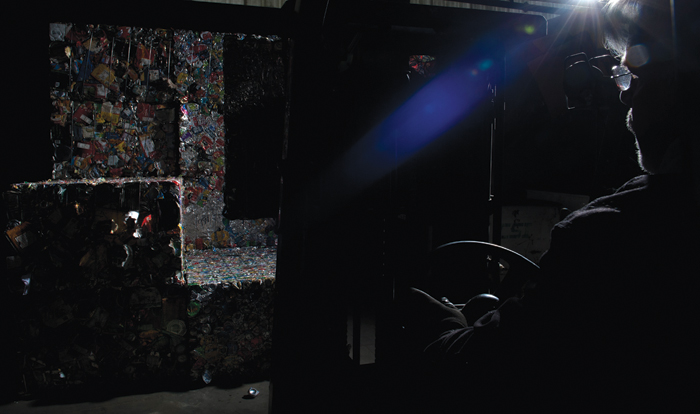Blaine County Recycle Center Supervisor Lamar Waters uses a forklift to stack bundles of compressed plastics at the Ohio Gulch facility. At The Store The first thing to note is that many companies actually sell water in recycled plastic bottles. The U.S. Environmental Protection Agency states on its website that most plastic water bottles and other beverage bottles are made from PET, or polyethylene terephthalate, which is marked with a number "1" on the bottom of the bottle. The EPA states that PET is one of the most commonly recycled plastics, and there is a growing demand for it. The plastics industry has also started to reduce the amount of plastic actually used in packaging, allowing recycled products to stretch further. However, PET is not the only type of plastic recycled in Blaine County. The Blaine County Recycle Center recycles plastics type 1 through 5, which includes milk jugs, baby bottles and deli containers. Those planning to recycle a product's packaging later should check that number before making a purchase. In addition to plastics, all aluminum beverage cans can be recycled in Blaine County, regardless of size. At Home At The Recycle Center Blaine County Outreach and Education Coordinator Bronwyn Nickel said Blaine County residents and visitors recycled 1,627 tons of material last year, all of which passed through the center. That's slightly down from 2012, she said, but recycling rates jumped so high from 2011 to 2012 that overall long-term numbers are still up. Once at the center, materials are sorted, compacted and made ready for shipping. Waters works with two main brokers: Aluminum goes to Green Team Solutions, based in Logan, Utah, and plastic goes to Western Recycling, which has an office in Boise. The Processors From there, the plastics are melted, stretched and pelletized. A video produced by Marglen Industries, a PET recycling and processing plant located in Georgia, shows how plastic is melted, stretched and turned into pellets. The video can be viewed at www.youtube.com/watch?v=TL_qH1ra7J0. Depending on quality, the material is then either sent off to make new bottles, or it's further stretched and spun into fiber. Waters said the fiber from Blaine County plastics is typically turned into carpets or stuffing for pillows or mattresses. Cardboard, he said, is sold to a company called International Paper in Springfield, Ore., through Western Recycling. The cardboard is actually taken by a True Value Hardware truck that has Ketchum as the last stop on its route. Rather than driving back to Oregon with an empty truck, the hauler picks up 42,000 pounds of cardboard a week from the center and brings it to the processing plant. From there, Waters said, the cardboard is turned into a "paper soup" that can either be turned into brown paper—like the kind used in paper bags—or lightweight cardboard, depending on quality. As for aluminum, the transformation is a little more straightforward. Waters said Western Recycling sells its aluminum—which is melted into ingots before being turned into aluminum sheeting—to processing plants that turn around and sell the materials back to beverage companies such as Anheuser-Busch and Coors. "It's domestic," he said. "It stays in the country. And within 60 days of you throwing out a can, it could be right back on the shelf." Back At The Store |
|
Copyright 2014 Express Publishing Inc. All Rights reserved. Reproduction in whole or in part in any form or medium without express written permission of Express Publishing Inc. is strictly prohibited. Sun Valley Guide and Habitat magazines are distributed free, four times a year to residents and guests throughout the Sun Valley, Idaho resort area communities. To subscribe to Sun Valley Guide and Habitat magazines visit http://svguide.com/subs |

